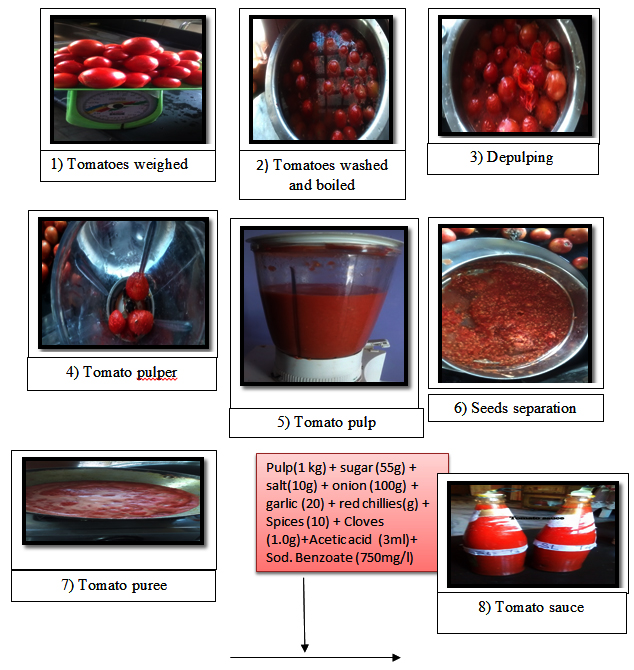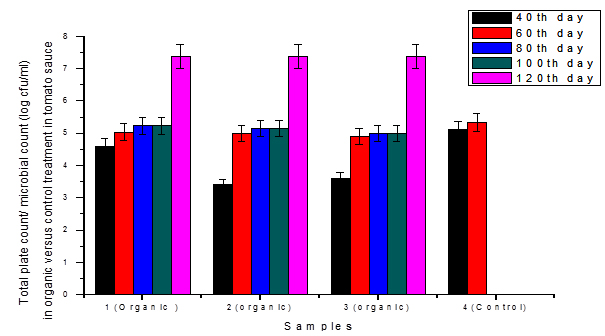ISSN: 0973-7510
E-ISSN: 2581-690X
Food quality and safety are of concern to every individual. Quality can be considered as a complex characteristic of food that determines its value or acceptability to a consumer. Consumer awareness of the relationship between foods and health together with environmental concerns has led to an increased demand for organically produced food. The post harvest products of tomato are being consumed in form of tomato ketch-up. Keeping in view the quality and safety of consumers the following studies were undertaken to evaluate the food safety in tomato ketch-up prepared from organic and conventionally grown tomato cultivar (Solan Lalima). The organic and conventional tomato ketchup was analyzed for microbiological spoilage and safety parameters at every 20 day interval, during storage. For enumeration of microorganisms present in each sample, 10-fold serial dilutions was followed and the colonies were counted on nutrient agar media after 24 h incubation at 37ºC at 20 day time interval. The shelf life of the organic sauce was found to be over 20 days then the control sample. It can be concluded that, the organic system of cultivation is good for environment, human health having attractive returns to the farmers.
Tomato, Ketch-up, Organic, Conventional
Food safety is defined as the assurance that the food will not cause harm to the consumer when it is prepared or eaten according to its intended use (FAO/WHO, 1997). From 1996 to 2008, eighty two food borne illness outbreaks were associated with the consumption of fresh produce. Of these, produce related out breaks, 14 (17.1%) were linked to tomatoes: fresh-cut tomatoes were associated with 5 of the 14 tomato outbreaks. During this time period, tomato associated outbreaks accounted for 1,927 illnesses and 3 deaths. All of the tomato associated outbreaks were due to bacterial agents. Many factors may play a role in the increased incidence and reporting of food borne illness outbreaks that implicate fresh produce, such as an aging population that is susceptible to food borne illness, an increase in global trade, a more complex supply chain, improved surveillance and detection of food borne illness, improvements in epidemiological investigation and increasingly better methods to detect pathogens (Lampel et al, 2000; Allos et al, 2004; Ragab et al, 2008). Tomatoes may be minimally processed to obtain ready to eat products and these steps include selection, washing, cleaning, stem removal, cutting, packaging and storage. Epidemiological data from the EU have identified one salmonellosis outbreak and one Norovirus outbreak associated with tomato consumption between 2007 and 2012. Risk factors for tomato contamination by Salmonella and Norovirus were considered in the context of the whole food chain. Available estimates of the Salmonella and Norovirus occurrence in tomatoes were evaluated together with mitigation options relating to prevention of contamination and the relevance of microbiological criteria. It was concluded that each farm environment represents a unique combination of risk factors that can influence occurrence and persistence of pathogens in tomato production. Appropriate implementation of food safety management systems including Good Agricultural Practices (GAP), Good Hygiene Practices (GHP) and Good Manufacturing Practices (GMP), should be primary objectives of tomato producers. According to Lairon D 2009, Food security, nutritional quality and safety vary widely around the world. Reaching these three goals is one of the major challenges for the near future. In line with several published literature reviews, the French Agency for Food Safety (AFSSA) performed an up to date exhaustive and critical evaluation of the nutritional and sanitary quality of organic food. This review is based on the AFSSA report issued and recently published studies. The major points are: (1) organic plant products contain more dry matter and minerals (Fe, Mg); and contain more antioxidant micronutrients such as phenols and salicylic acid, (2) organic animal products contain more polyunsaturated fatty acids, (3) data on carbohydrate, protein and vitamin levels are insuûciently documented, (4) 94–100 percent of organic food does not contain any pesticide residues, (5) organic vegetables contain far less nitrates, about 50 percent less; and (6) organic cereals contain overall similar levels of mycotoxins as conventional ones. Thus, organic agricultural systems have already proved to be able to produce food with high quality standards.
Microbiological safety of tomato product (Ketchup)
Preparation of Raw material (Tomato puree)
Ripened (90%) tomato fruits (10kg each) of both organic treatment and control (cv. Solan Lalima) were washed with water to remove adherent foreign material and dust. Tomato puree was prepared by cutting tomato in two halves, boiling for 10 minutes and finally passing through tomato pulper for separating seeds and skin. Extracted juice was heated with constant stirring till it reaches 9p Brix. It was then filled in the pre-sterilized 650ml capacity glass bottles which were sealed, pasteurized for 30 minutes in boiling water and cooled in air. The product was labeled and stored under ambient conditions for later use (Fig 1).
Fig. 1. Pictorial flow sheet for the method followed for the preparation of Tomato sauce from tomato pu-ree
Preparation of Tomato sauce from Tomato puree
Sauce was prepared from tomato puree (9æ%B) as per the procedure given by Lal et al, 1986. Puree was heated slightly and the spice bag containing predetermined quantities of coarsely ground cardamom, black pepper and cumin, powdered red chillies, cloves and finally chopped onion and garlic (Table 1) was placed in the tomato puree during boiling. After that one third of sugar was added initially at the time of commencing the boiling. Salt was added towards end of boiling (Fig 3.10). When the sauce was ready i.e. TSS 27p B or above, sodium benzoate @ 750mg/L and acetic acid @ 3ml/kg were added. The sauce was hot filled in pre-cleaned and sterilized, dry glass bottles. Bottles were crown corked and stored at room temperature.
Table (1):
Details of the ingredients used for the preparation of sauce.
S.No. |
Ingredients |
Quantity |
|---|---|---|
1. |
Pulp (kg) |
1 |
2. |
Sugar (gms) |
55 |
3. |
Salt (gms) |
10 |
4. |
Onion (gms)(Finally chopped) |
100 |
5. |
Garlic (gms), finally chopped |
20 |
6. |
Spices(coarse grinded)(gms), (cardamom,black pepper, Zeera) |
10 |
7. |
Red chillies (powdered in gms) |
1.4 |
8. |
Cloves(gms) |
1.0 |
9. |
Acetic acid (ml) |
3.0 |
10. |
Sod. Benzoate (mg/l) |
750 |
Fig. 2. Total plate count (log cfu/ml) of ketchup produced from organically and conventionally grown tomatoes
Storage
The final tomato product (Ketchup) was stored for a period of 6 months.
Total Microbial load analysis
The organic and conventional tomato ketchup was analyzed for microbiological spoilage and safety parameters at every 20 day interval, during storage. For enumeration of microorganisms present in each sample, 10-fold serial dilutions was followed and the colonies were counted on nutrient agar media after 24 h incubation at 37ºC at 20 day time interval. The analysis was carried out in triplicate and the results were expressed as log cfu/ml.
Formula used: Total CFU/ml of tomato sauce = No. of colonies x Dilution factor / Volume of inoculums
(Dilution factor= Reciprocal of dilution)
Food safety in tomato product
Microbial load in tomato product (ketchup)
The assessment of total microbial load was carried out during 2014 for determining the food product safety and shelf life of tomato ketchup processed under organic and conventional treatments for a time period of 120 days analyzed samples for every 20 day interval (Fig 2). On zero and twentieth day, no microbial load was detected in organic as well as control tomato sauce samples. On 40th day, the microbial load in three organic sample was observed to be 4.6 log cfu/ml, 3.4 log cfu/ml, 3.6 log cfu/ml, respectively, whereas the control sample was recorded with 5.11 log cfu/ml load. At the 60th day, the organic samples were recorded with total microbial load of about 5.04 log cfu/ml, 5 log cfu/ml, 4.91log cfu/ml, and control sample with 5.33 log cfu/ml. However, the analysis of tomato organic samples revealed that the microbial load on 80th day of study was about 5.23 log cfu/ml, 5.14 log cfu/ml, 5 log cfu/ml, whereas the control treatment showed complete deterioration of sauce (colonies over 500 cfu/ml). The 100th day was recorded with a microbial count of 5.29 log cfu/ml in organic samples. On the 120th day the spoilage of organic tomato sauce was recorded with 7.37 log cfu/ml and was finally observed to be deteriorated.
The shelf life of the organic sauce was found to be over 20 days then the control sample. The microbial load was detected below the acceptable limits by FAO during the study.
The data pertaining to microbial spoilage of organic and conventional tomato ketchup revealed that organic ketchup showed a better shelf life as compared to control. It was observed that the organic ketchup has improved shelf life (over 20 days) as compared to the untreated check. The improved shelf life and less microbial load in organic samples can be attributed to the increased Ca+2, phenol, lycopene, ascorbic acid contents and fruit firmness, (Subbiah and Perumal, 1996; Gracia et al, 1996) making the cell wall and tissues more resistant and less accessible to the enzymes that are produced by fungi and bacteria, limiting infection while controlling ripening, softening, storage breakdown, rotting and decay at the same time ( Izumi and Watada 1994) and reduce the disease index (De-Souza et al, 1999). Organic acids produced under organic cultivation which influence its shelf life and organoleptic properties such as colour brightness and anti-inflammatory, anti-allergic and anti-thrombotic properties. Organic produce tends to store better and has longer shelf life, probably because of lower levels of nitrates and higher average levels of antioxidants (Theuer, 2014).
The shelf life of organically grown tomatoes was higher than the conventional ones. It can be concluded that by following appropriate organic practices, the post harvest products can be stored for longer periods as compared to conventional products. The Shelf life of tomato sauce grown organically was reported to increase as compared to conventional one.
ACKNOWLEDGMENTS
None.
CONFLICT OF INTEREST
The authors declare that there is no conflict of interest.
- FAO/WHO. Codex Alimentarius Food Hygiene Basic Texts. Joint FAO/WHO Food Standards Programme, Codex Alimentarius Commission.Pub. # M-83; 1997.
- Lampel, K.A., Orlandi, P.A., Kornegay, L. Improved Template Preparations for PCR-Based Assays for Detection of Food-Borne Bacterial Pathogens. Applied and Environmental Microbiology. 2000; 66(10): 4539-4542.
- Allos, B.M., Moore, M.R., Griffin, P.M., Tauxe, R.V. Surveillance for Sporadic Foodborne Disease in the 21st Century, The Food Net Perspective. Clinical Infectious Disease. 2014; 38(3): 115-120.
- Lairon, D. Nutritional quality and safety of organic food. A review. Agronomical Sustainable Development. Biochemistry. 2009; 48(26): 6157-6165.
- Lal, G., Siddapa, G.S., Tandon, G.L. Preservation of fruits and vegetables, revised edition. Indian council of Agricultural Research. 1986; New Delhi, India.
- Subbiah, S., Perumal, G.R. Post harvest treatment of mangoes with calcium. Tropical Science. 1996; 36: 14-17.
- Gracia, J.M., Herrera, S., Morilla, A. Effects of postharvest dips in calcium chloride on strawberry. Journal of Agriculture and Food Chemistry. 1996; 44: 30-33.
- Izumi, H., Watada, A.E. Calcium treatments affect storage quality of shredded carrots. Journal of Food Science Technology. 1994; 59: 106-109.
- Theurer, L.K. Complexity based theories of emergence: criticism and constrains. In. studies in philosophy of science. 2014; 28(3): 277-301.
- Ragab, A., Mergawi, Khalid, R. Effect of organic and conventional production practices on antioxidant activity, antioxidant constituents and nutritional value of tomatoes and carrots in Saudi Arabia markets. Food Agriculture and Environment. 2010; 8(3, 4): 253-258.
© The Author(s) 2018. Open Access. This article is distributed under the terms of the Creative Commons Attribution 4.0 International License which permits unrestricted use, sharing, distribution, and reproduction in any medium, provided you give appropriate credit to the original author(s) and the source, provide a link to the Creative Commons license, and indicate if changes were made.




